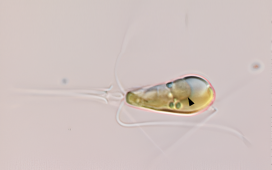In an honorable example of fair play, giraffes pick similar-sized opponents to ensure a ‘square go’, a new study reveals.
From observations in South Africa, researchers at the University of Manchester found males practiced head butts with males of similar stature.
Giraffe males fight for ‘access to a large number of females’ by launching their ossicones – the two skin-covered bone structures at the top of their heads – at their opponents, using their long necks for leverage.
The force of a particular powerful impact can cut into flesh, wounding and sometimes even killing a fighter.

Giraffe males practice head butts with males of similar stature, in an honorable example of fair play, researchers at the University of Manchester report. Pictured, two giraffes go at each other in a head-to-head position
For the first time, researchers also report that individuals displayed strong ‘laterality’ when fighting – in other words, the position they take up when dueling depends on if they’re ‘righties’ (right-orientated) or ‘southpaws’ (left-orientated).
Individuals consistently preferred delivering blows from either their left or right side, and these preferences dictated the orientation of sparring bouts – whether they stood head-to-head or head-to-tail.
If one giraffe was left-orientated and the other right, they would stand head-to-head so they could each come at the other from their preferred side.
Conversely, if both were left-orientated, or both right-orientated, they would stand head-to-tail.
Interestingly, opponents respected this preference and didn’t try to unfairly outfox their opponent by standing on their weaker side.
‘Fighting is extremely rare because it’s extremely violent,’ study author Jessica Granweiler at the University of Manchester told the New York Times.
‘I don’t know if it’s a mutual agreement – respect my side and I’ll respect yours. Never did I see a male try and cheat.’
Interestingly, there was more of an equal split between lefties and righties in the observed giraffes, compared with humans, who are mostly right-handed.
The team looked at northern giraffes (Giraffa camelopardalis) in the Mogalakwena River Reserve in South Africa between November 2016 and May 2017.
As the species name suggests, this species of giraffe is native to North Africa, but the animals were housed at a private fenced reserve.

Giraffe males, known as bulls, fight each other in either a head-to-head position (a) or a head-to-tail position (b) before delivering blows
Researchers found that sparring bouts were most frequently observed in young adults, and between males that were more evenly matched in size.
Fights between males of similar body size were also characterised by being of high intensity and of short duration, they found.
‘These results support the suggestion that sparring functions principally to provide maturing males a means of testing their competitive ability without escalating to full-scale fights,’ Granweiler and her co-authors point out.

Researchers studied a population of giraffes living on a private fenced reserve in Limpopo, South Africa
The team also noticed a ‘bar brawl’ effect, where one fight seemed to spark other giraffe fights nearby.
Amazingly, the fights sometimes had a responsible ‘referee’ – older, mature males occasionally broke up matches between younger males.
‘This is a clever way to sow confusion among the lower ranking males to maintain dominance and monopolize the females,’ said Monica Bond at the University of Zurich in Switzerland, who was not involved in this study.
‘As with most mammals, it’s a tough world out there for the guys.’

Sparring indicated a seasonal peak which coincided with the onset of the wet season. This graph from the paper shows this seasonal variation in sparring bouts. Bars indicate the rate of observed sparring per month. The blue line indicates the seasonal pattern of daily rainfall (mm)
Researchers also found that sparring displayed a seasonal peak which coincided with the onset of the wet season and ‘possibly reflected the increased aggregation of males at this time’.
This wet season, which also coincided with the greening of the vegetation, notably peaked at around December.
The study is important because the more that we understand giraffe behaviour, the better zookeepers could look after the animals.
‘A more nuanced understanding of how social and environmental factors shape interactions among individuals, such as sparring, will improve our understanding and management of this charismatic animal,’ Granweiler and her team say.
The study has been published in the journal Ethology.















